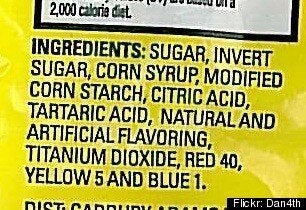
Try finding out how much sugar has really been added to your yogurt, cereal, bread or energy bar, and watch the hours fly by!
Although the FDA (and the USDA) has certainly acknowledged and tried to define the term "added sugars," or those sugars that aren't naturally occurring in foods (for example, fruits), the government is leaving it up to us to be food detectives and learn all the various names for sugar and, more importantly, how much of it we're actually putting in our mouths.
Sugar masquerades under a variety of guises, such as dextrose, fructose, fruit juice concentrates, glucose, invert sugar and maltose, but trying to figure out what percentage of calories these sugars represent in a packaged food product is akin to scoring a concert ticket to Lady Gaga -- it's pretty much impossible.
That's because the FDA has refused to add an "Added Sugars" line (in grams) within the "Sugars" section on the nutrition facts label. Instead, added sugars are only mentioned in the ingredient list -- and only in decreasing weight order, not by percentage of calories.
Realizing this loophole, some food companies seem to be taking some extreme liberties. Not only are they using some of those tricky sugar synonyms in the ingredient list, but they're also using several of them, in a single product. Added sugars are added sugars. No matter what you call them, they do pretty much the same thing to food (make it taste sweeter). So by dividing the total amount of added sugars into three or four different sugar names instead of using just one type of sugar, companies are able drop their added sugars further down the list (the less the weight, the lower the rank on the ingredient list).
So for example, if a manufacturer wants to sweeten up a certain brand of crackers, it can either do this using 15 grams of "sugar" or, 5 grams of "malt syrup," 5 grams of "invert sugar" and 5 grams of "glucose". Some manufacturers seem to be choosing this divide and masquerade method, placing these ingredients lower down on their products' lists, making us believe that the amount of sugar in the product is smaller than it is. Bingo!
Here are four examples of foods that have divided their total added sugar content between several confusing synonyms (note where these names are positioned on the ingredient list).
Chocolate Chip Bars
Granola (whole grain oats, brown sugar, crisp rice (rice flour, sugar, salt, malted barley extract), whole grain rolled wheat, soybean oil, dried coconut, whole wheat flour, sodium bicarbonate, soy lecithin, caramel color, nonfat dry milk), corn syrup, semisweet chocolate chips, brown rice crisp, sunflower oil, oligofructose, polydextrose, corn syrup solids, glycerin. Contains 2 percent or less of water, invert sugar, salt, molasses, sucralose, natural and artificial flavor, BHT, citric acid
Nutrition Bars
Soy protein nuggets, Yogurt coating (sugar, palm kernel oil, nonfat fry milk solids, Yogurt powder, soy lecithin, salt), corn syrup, milk protein isolate, fructose, almonds, palm oil, water
Wheat Thins
Whole grain wheat flour, unbleached enriched flour, soybean oil, sugar, cornstarch, malt syrup, salt, invert sugar, monoglycerides, leavening, vegetable color
Club Crackers
Enriched flour, soybean oil with TBHQ for freshness, sugar, contains two percent of less of: salt, leavening, high fructose corn syrup, corn syrup, cornstarch, soy lecithin
Why should we be concerned about added and refined sugars anyway? Because we're getting way too much of it, and all those extra, nutritionally empty calories can contribute, in many diets, to obesity, type 2 diabetes, and risk factors for heart disease, according to the American Heart Association. As noted by the Center for Science in the Public Interest (CSPI), people who consume diets high in added sugars consume lower levels of fiber, vitamins and minerals, and other nutrients, and by displacing these protective nutrients, added sugars may increase the risk of osteoporosis, certain cancers, high blood pressure and other health problems.
What can you do? 1. Educate yourself. I've included a list of sweeteners below for you to reference when you're checking labels. 2. You can write the FDA or call your congressperson and demand more transparency in food labeling for added sugars and join organizations such as CSPI that have been petitioning for these rules for the last several years.
Sugar Consumption Stats:
- The average American consumes at least 64 pounds of sugar per year, and the average teenage boy at least 109 pounds.
- Per capita consumption of added sugars has risen by 28 percent since 1983.
- Americans consume 22 teaspoons of added sugars a day, teens 34 teaspoons.
Common sweeteners:
corn sweetener, corn syrup, dextrose, fructose, fruit juice concentrates, glucose, high-fructose corn syrup, invert sugar, lactose, maltose, malt syrup, raw sugar, sucrose, sugar syrup, cane crystals, cane sugar, crystalline fructose, evaporated cane juice, corn syrup solids, malt syrup.
Pooja Mottl is a healthy living advisor and candidate of the Chefs Program at the Natural Gourmet Institute. She holds a certificate in Plant Based Nutrition from Cornell University in conjunction with the T. Colin Campbell Foundation as well as an NSCA-CPT certification in fitness.